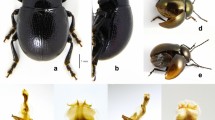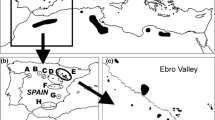Summary
Loss of flying ability has been related to habitat stability, but even within stable habitats most species retain the ability to fly. What other factors are associated with flightlessness in forest species? I used both simple and phylogeny-based comparative methods to examine traits associated with the evolution of reduced wings in temperate forest Macrolepidoptera. Non-phylogenetic comparisons show that the 33 species with reduced wings in this data set tend to be spring feeding, overwinter as eggs, place eggs in clusters or a single mass, have winter-active adults and have high host breadth, high fecundity and outbreaking population dynamics. Phylogenetic analysis revealed that the seven independent origins of reduced wings occurred only in springfeeding lineages. The origins of reduced wings were also related to the other variables, although correlations were much less strong for egg clustering and host breadth. The fecundity of wing-reduced species and their macropterous sister species were not different, but few data were available.
Similar content being viewed by others
References
Barbosa, P., Krischik, V.A. and Lance, D. (1989) Life-history traits of forest-inhabiting flightless Lepidoptera.Am. Midl. Nat. 122, 262–74.
Bell, G. (1982)The Masterpiece of Nature. University of California Press, Berkeley, CA.
Bolte, K.B. (1990) Guide to the Geometridae of Canada (Lepidoptera). VI. Subfamily Laurentiinae 1. Revision of the genusEupithecia.Entomol. Soc. Can. Mem. 151, 1–253.
Buckler, W. (1896)The Larvae of British Butterflies and Moths. The Ray Society, London.
Carter, J.D. (1984)Pest Lepidoptera of Europe. Dr W. Junk Publishers, Dordrecht.
Cook, M.A. and Scoble, M.J. (1992) Tympanal organs of geometrid moths: a review of their morphology, function, and systematic importance.Syst. Entomol. 17, 219–32.
Courtney, S.P. (1984) The evolution of egg clustering by butterflies and other insects.Am. Nat. 123, 276–81.
Edmunds, G.F. and Alstad, D.N. (1978) Coevolution in insect herbivores and conifers.Science 199, 941–5.
Emmet, A.M. and Heath, J. (1991)The Moths and Butterflies of Great Britain and Ireland. Vol. 7(2). Lasiocampidae—Thyatiridae with life history chart of the British Lepidoptera. Harley Books, Colchester.
Ferguson, D.C. (1978)The Moths of America North of Mexico including Greenland. Noctuoidea: Lymantriidae. E.W. Classey and Wedge Entomological Research Foundation, London.
Furniss, M.M. and Carolin, V.M. (1977)Western Forest Insects. USDA Forest Service Miscellaneous Publication, 1339 Washington DC.
Hackman, W. (1966) On wing reduction and loss of wings in Lepidoptera.Notulae Entomologica 46, 1–16.
Hodges, R.W., Dominick, T., Davis, D.R., Ferguson, D.C., Franclemont, J.G., Munroe, E.E. and Powell, J.A. (1983)Check List of the Lepidoptera of America North of Mexico. E.W. Classey and R.B.D. Publications, London.
Hunter, A.F. (1991) Traits that distinguish outbreaking and non-outbreaking Macrolepidoptera feeding on northern hardwood trees.Oikos 60, 275–82.
Hunter, A.F. (1993) Gypsy moth population sizes and the window of opportunity in spring.Oikos 68, 531–8.
Hunter, M.D. (1990) Differential susceptibility to variable plant phenology and its role in competition between two insect herbivores on oak.Ecol. Entomol. 15, 401–8.
Karban, R. (1989) Fine-scale adaptation of herbivorous thrips to individual host plants.Nature 340, 60–1.
Liebhold, A.M. and Elkinton, J.S. (1990) Models of the spatial dynamics of epidemic gypsy moth populations. InPopulation dynamics of forest insects (A.D. Watt, S.R. Leather, M.D. Hunter and N.A.C. Kidd, eds), pp. 359–67. Intercept, Andover, UK.
Lyons, D.B. and Lysyk, T.J. (1989) Development and phenology of eggs of the gypsy moth,Lymantria dispar (Lepidoptera: Lymantriidae) in Ontario. InProceedings: Lymantriidae: a comparison of features of New and Old World tussock moths. (W.E. Wallner and K.E. McManus, eds) pp. 351–66 USDA Forest Service General Technical Report NE 123 Washington DC.
McGuffin, W.C. (1967) Guide to the Geometridae of Canada (Lepidoptera). I. Subfamily Sterrhinae.Entomol. Soc. Can. Mem. 50.
McGuffin, W.C. (1972) Guide to the Geometridae of Canada (Lepidoptera). II. Subfamily Ennominae. 1.Entomol. Soc. Can. Mem. 86.
McGuffin, W.C. (1977) Guide to the Geometridae of Canada (Lepidoptera). II. Subfamily Ennominae. 2.Entomol. Soc. Can. Mem. 101.
McGuffin, W.C. (1981) Guide to the Geometridae of Canada (Lepidoptera). II. Subfamily Ennominae. 3.Entomol. Soc. Can. Mem. 117.
McGuffin, W.C. (1989) Guide to the Geometridae of Canada (Lepidoptera). II. Subfamily Ennominae. 4.Entomol. Soc. Can. Mem. 138.
McGugan, B.M. (1958)Forest Lepidoptera of Canada, Vol. 1. Canada Department of Agriculture Publication 1034, Ottawa.
Maddison, W.P. (1990) A method for testing the correlated evolution of 2 binary characters: are gains and losses concentrated on certain branches of a phylogenetic tree?Evolution 44, 539–57.
Maddison, W.P. and Maddison, D.R. (1992)MacClade 3.01: Analysis of Phylogeny and Character Evolution. Sinauer, Sunderland, MA.
Mattson, W.J. and Scriber, J.M. (1987) Nutritional ecology of insect folivores of woody plants: nitrogen, water fiber and mineral considerations. InNutritional ecology of insects, mites, spiders and related invertebrates (F. Slansky, Jr and J.G. Rodriguez, eds), pp 105–46. Wiley, New York.
Mattson, W.J., Herms, D.A., Witter, J.A. and Allen, D.C. (1991) Woody plant grazing systems: North American outbreak folivores and their host plants. InForest insect guilds: patterns of interactions with host trees (Y.N. Baranchikov, W.J. Mattson, F.P. Hain and T.L. Payne, eds), pp 53–84. USDA Forest Service General Technical Report NE-153 Washington DC.
Mitter, C., Futuyma, D.J., Schneider, J.C. and Hare, D.J. (1979) Genetic variation and host plant relations in a parthenogenetic moth.Evolution 33, 777–90.
Møller, A.P. and Birkhead, T.R. (1992) A pairwise comparative method as illustrated by copulation frequency in birds.Am. Nat. 139, 644–56.
Moore, L.V., Myers, J.H. and Eng, R. (1988) Western tent caterpillars prefer the sunny side of the tree, but why?Oikos 51, 321–6.
Myers, J.H. (1992) Experimental manipulation of the phenology of egg hatch in cyclic populations of tent caterpillars.Can. Entomol. 124, 737–42.
Nothnagle, P.J. and Schultz, J.C. (1987) What is a forest pest? InInsect outbreaks (P. Barbosa and J.C. Schultz, eds), pp. 59–80. Academic Press, San Diego.
Prentice, R.M. (1962)Forest Lepidoptera of Canada, Vol. 2. Canada Department of Forestry Bulletin 128, Ottawa.
Prentice, R.M. (1963)Forest Lepidoptera of Canada, Vol. 3. Canada Forestry Branch Department Publication 1013, Ottawa.
Price, P.W., Cobb, N., Craig, T.P., Wilson Fernandes, G., Itami, J.K., Mopper, S. and Preszler, R.W. (1990) Insect herbivore population dynamics on trees and shrubs: new approaches relevant to latent and eruptive species and life table development. InInsect—plant interactions, (E.A. Bernays, ed.),Vol. II, pp. 1–38. CRC Press, Boca Raton, FL.
Proctor, H.C. (1991) The evolution of copulation in water mites: a comparative test for nonreversing characters.Evolution 45, 558–67.
Raupp, M.J. and Denno, R.F. (1983) Leaf age as a predictor of herbivore distribution and abundance. InVariable plants and herbivores in natural and managed systems (R.F. Denno and M.S. McClure, eds), pp. 91–121. Academic Press, New York.
Rindge, F.H. (1975) A revision of the new world Bistonini (Lepidoptera: Geometridae).Bull. Am. Museum Natural History 156, 69–155.
Roff, D.A. (1986) The evolution of wing dimorphism in insects.Evolution 40, 1009–20.
Roff, D.A. (1990) The evolution of flightlessness in insects.Ecol. Monogr. 60, 389–421.
Roff, D.A. (1994) The evolution of flightlessness: is history important?Evol. Ecol.,8, 639–657.
Rose, A.H. and Lindquist, O.H. (1984)Insects of Eastern Pines. Can. Forest Service Publication 1313, Ottawa.
Rose, A.H. and Lindquist, O.H. (1985)Insects of Eastern Spruces, Fir and Hemlock. Can. Forest Service General Technical Report 23, Ottawa.
Rose, A.H. and Lindquist, O.H. (1992)Insects of Eastern Larch, Cedar and Juniper. Can. Forest Service General Technical Report 28, Ottawa.
Sattler, K. (1991) A review of wing reduction in Lepidoptera.Bull. Br. Museum Natural History (Entomol.)60, 243–88.
Schaefer, P.W. (1989) Diversity in form, function, behaviour and ecology: an overview of the Lymantriidae (Lepidoptera) of the world. InProceedings Lymantriidae: a comparison of features of New and Old World tussock moths (W.E. Wallner and K.A. McManus, eds), pp. 1–20. USDA Forest Service General Technical Report NE-123 Washington DC.
Schneider, J.C. (1980) The role of parthenogenesis and female aptery in microgeographic ecological adaptation in the fall cankerworm,Alsophila pometaria Harris (Lepidoptera: Geometridae).Ecology 61, 1082–90.
Shepherd, R.F. (1992) Relationships between attack rates and survival of Western spruce budworm,Choristoneura occidentalis Freeman (Lepidoptera: Tortricidae), and bud development of Douglas-fir,Pseudotsuga menziesii (Mirb.) Franco.Can. Entomol. 124, 347–58.
Skou, P. (1986) The Geometroid moths of North Europe.Entomonograph 6, 1–348.
Sillén-Tullberg, B. (1993) The effect of biased inclusion of taxa on the correlation between discrete characters in phylogenetic trees.Evolution 47, 1182–91.
Sokal, R.R and Rohlf, F.J. (1981)Biometry, 2nd edn. W.H. Freeman and Co. New York.
Stamp, N.E. (1980) Egg deposition patterns in butterflies: why do some species cluster their eggs rather than deposit them singly?Am. Nat. 115, 367–80.
Stokoe, W.J. and Stovin, G.H.T. (1948)The Caterpillars of British Moths Including the Eggs, Chrysalids, and Food Plants, Vols 1 and 2. Frederick Warne and Co., London.
Wagner, D.L. and Liebherr, J.K. (1992) Flightlessness in insects.TREE,7, 216–20.
Watt, K.E.F. (1965) Community stability and the strategy of biological control.Can Entomol. 97, 887–95.
Author information
Authors and Affiliations
Rights and permissions
About this article
Cite this article
Hunter, A.F. The ecology and evolution of reduced wings in forest macrolepidoptera. Evol Ecol 9, 275–287 (1995). https://doi.org/10.1007/BF01237773
Issue Date:
DOI: https://doi.org/10.1007/BF01237773




